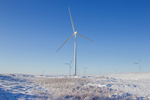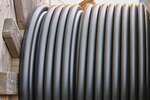06/23/2010
Product Pick of the Week - The Superturbine
Offshore looks like the next big expansion area for the wind industry. Conventional ideas extended to offshore tasks will mount turbines on towers anchored to the ocean floor in not much more than 30-m depths. Floating turbines, however, would allow placing them farther from shore but will probably be expensive. Inventor Doug Selsam suggests an answer to the shortcomings with some out-of-the-box thinking in his Superturbine (superturbine.net), a floating design that omits the tower altogether and sports several other advantages.
For instance, a direct-drive generator would mount in a floating pod tethered to the ocean floor so water depth becomes less of an issue. A long carbon-composite tube would hold rotors positioned along its length while sea breezes provide lift to keep the string of rotors aloft. Selsam says the design omits all components that do not contribute to power generation, resulting in a low cost turbine. This stripped-down design would be more efficient, cheaper, and easier to produce, he says, than what he calls lumbering windmills. They’re also more versatile. For instance, they could be attached atop skyscrapers.
Selsam has been nurturing the multi-rotor turbine for several years in prototypes that have produced more power than similarly sized single-rotor units. For instance, prototypes of his initial idea put several 7-ft, two-blade rotors on a single shaft that runs through a generator. With one more rotor downstream than upstream, the unit points into the wind without a rudder or yaw motors. In 32.5 mph winds, this setup generates 6 kW, about six times more power, he reports, than a 7-ft single-rotor turbine would produce in the same wind.
“The rotors act like gyroscopes stabilizing the driveshaft where they attach,” he says. “Because smaller diameter rotors turn at higher speeds than larger rotors on conventional units, a small and light direct-drive generator allows omitting a gearbox.”
Such a design, he says, is easily deployed on land or at sea. The effectiveness of offshore versions is amplified by attaching a balloon to lift the free end. When necessary, this design can lay itself down on the sea, or submerge completely using flooding chambers. Selsam says it would pose no risk to passing vessels, because it is relatively lightweight.
More advantages come from minimal spacing requirements. For instance, conventional wind farms separate rotors by several diameters to reduce downstream wake effects. But in Selsam’s design, the vertical offset allows closer placement because positioning the rotor array relative to the wind direction is predetermined. The top of one wake transits to the lower edge of the succeeding rotor, so energy normally lost to wake vorticity is recaptured. “Each rotor adds lift which helps support the driveshaft against gravity and downwind thrust forces. And the power reaching all rotors tends to be equal,” he says.
For more information please contact Trevor Sievert at ts@windfair.net
For instance, a direct-drive generator would mount in a floating pod tethered to the ocean floor so water depth becomes less of an issue. A long carbon-composite tube would hold rotors positioned along its length while sea breezes provide lift to keep the string of rotors aloft. Selsam says the design omits all components that do not contribute to power generation, resulting in a low cost turbine. This stripped-down design would be more efficient, cheaper, and easier to produce, he says, than what he calls lumbering windmills. They’re also more versatile. For instance, they could be attached atop skyscrapers.
Selsam has been nurturing the multi-rotor turbine for several years in prototypes that have produced more power than similarly sized single-rotor units. For instance, prototypes of his initial idea put several 7-ft, two-blade rotors on a single shaft that runs through a generator. With one more rotor downstream than upstream, the unit points into the wind without a rudder or yaw motors. In 32.5 mph winds, this setup generates 6 kW, about six times more power, he reports, than a 7-ft single-rotor turbine would produce in the same wind.
“The rotors act like gyroscopes stabilizing the driveshaft where they attach,” he says. “Because smaller diameter rotors turn at higher speeds than larger rotors on conventional units, a small and light direct-drive generator allows omitting a gearbox.”
Such a design, he says, is easily deployed on land or at sea. The effectiveness of offshore versions is amplified by attaching a balloon to lift the free end. When necessary, this design can lay itself down on the sea, or submerge completely using flooding chambers. Selsam says it would pose no risk to passing vessels, because it is relatively lightweight.
More advantages come from minimal spacing requirements. For instance, conventional wind farms separate rotors by several diameters to reduce downstream wake effects. But in Selsam’s design, the vertical offset allows closer placement because positioning the rotor array relative to the wind direction is predetermined. The top of one wake transits to the lower edge of the succeeding rotor, so energy normally lost to wake vorticity is recaptured. “Each rotor adds lift which helps support the driveshaft against gravity and downwind thrust forces. And the power reaching all rotors tends to be equal,” he says.
For more information please contact Trevor Sievert at ts@windfair.net
- Source:
- Online Editorial, www.windfair.net
- Author:
- Posted by Trevor Sievert, Online Editorial Journalist
- Email:
- ts@windfair.net
- Link:
- www.windfair.net/...
- Keywords:
- Wind energy, wind power, wind turbine, wind mill, offshore, onshore, wind farm, renewable energy


























